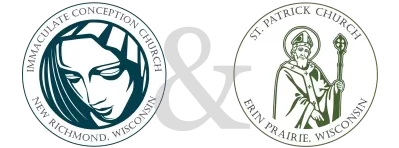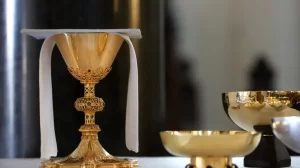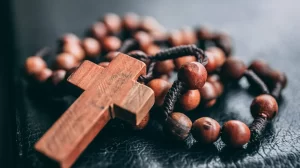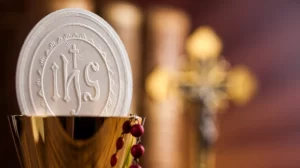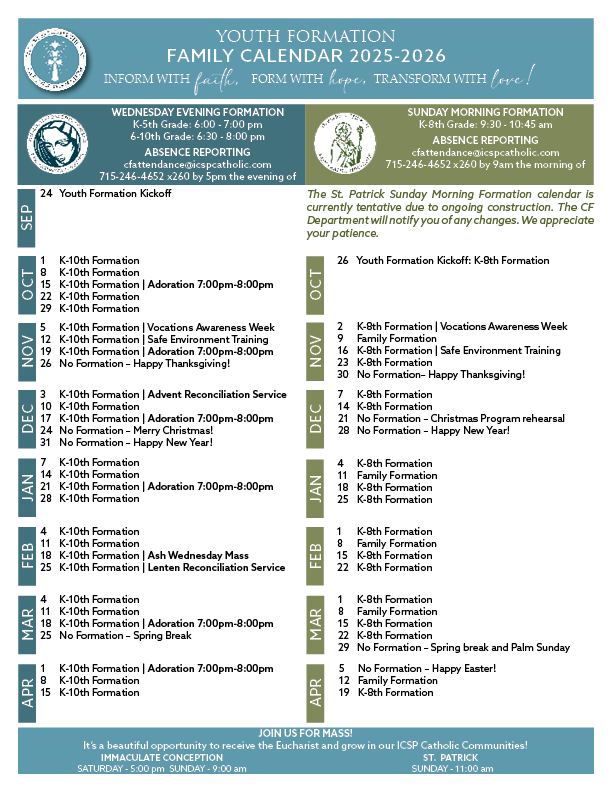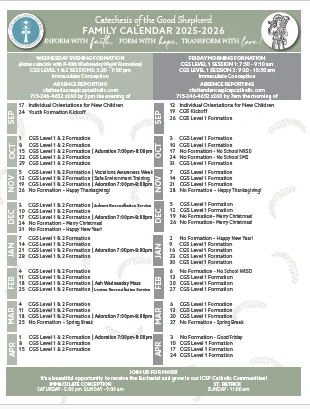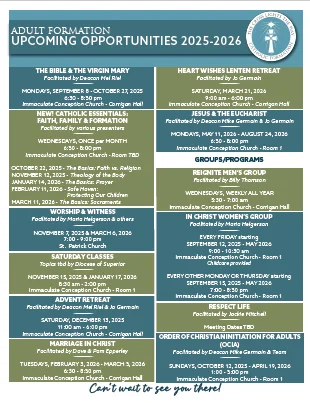
Location
1880 Co. Rd. G
New Richmond, WI 54017
Directions
Contact Info
(715) 246-4652
icspchurches@ic-church.com
Contact Us
Weekend Masses
Sunday: 11:00am
Giving / Tithing
Publications
Daily Masses
Friday: 9:30am
History & Heritage
- Fr. McGee (1857)
- Fr. Napoleon Mignault (1858-1862)
- Fr. Coffee (1862)
- Fr. Nicholas & James Stehle (1862-1864)
- Fr. John Conroy (1864-1869)
- Fr. Hugh Quigley D.D. (1869-1872)
- Fr. Peter J. Lavin (1872-1880)
- Fr. Martin C. Connolly (1880)
- Fr. Daniel Reddin (1880-1904)
- Fr. Patrick Lee (1903-1904)
- Fr. Patrick A Walsh (1905-1938)
- Fr. Daniel Slattery (1938-1940)
- Rev. James Griffin (1940-1953)
- Rev. Philip Krembs (1953-1958)
- Rev. Walter A. Torkildson (1958-1961)
- Rev. George Gleason (1961-1965)
- Rev. Peter Maak (1965)
- Rev. Daniel Dahlberg (1978-1988)
- Fr. Vincent Lynch (1981)
- Fr. Charles Murphy (1984)
- Fr. Martin Gibbons (1984-1988)
- Fr. Dennis Mullen (1988-1992)
- Fr. James Kraker (1992-1999)
- Fr. Charles Murphy (1998-1999)
- Fr. Leonard Fraher (1998-1999)
- Fr. Allan Bradley (1999-2004)
- Fr. James Brinkman (2004-2015)
- Fr. John Anderson (2015 – present)
The Pioneering Spirit and Early Seeds of Faith (1857-1864)
The story of St. Patrick Parish in Erin Prairie is deeply intertwined with the arrival of Irish immigrants in the early 1850s. Driven by the hardships of the potato famine and political unrest in Ireland, approximately 20 families sought a new life in the fertile lands of what became the Town of Erin Prairie (officially organized in 1853).
Little is documented about the parish’s formal existence before 1857. In the fall of that year, Father J.J. McGee, stationed in Hudson (then under the Diocese of Milwaukee), celebrated the first recorded Mass in Erin Prairie. The grateful community immediately began constructing a small log church. However, their efforts were cut short when Father McGee was reassigned.
In the fall of 1858, Father Napoleon Mignault was sent to Hudson as the second Catholic pastor in the area. From Hudson, he served the Erin Prairie community with monthly Masses held in the homes of parishioners.
The prospect of regular services spurred the community to build a more permanent church. In the spring of 1860, the late John Meath generously donated two acres of land, the site upon which the present church stands. A frame church was subsequently erected on this donated land.
The growing but still nascent parish faced further challenges. In the summer of 1862, Father Mignault left Hudson, leaving Erin Prairie without regular services. Occasional visits were made by Father Coffee from Hastings, Minnesota. Later in 1862, Fathers Nicholas and James Stehle, brothers stationed in Hudson, began attending to the spiritual needs of Erin Prairie until February 1864.
The early years were marked by the resilience of the Irish settlers, who, alongside their faith, brought aspects of their culture, including stories of (potential) Indian raids, community barn-raising events, and traditional Irish wakes. The dedication to their faith is highlighted by accounts of parishioners walking up to fifteen miles to attend Mass, often carrying their shoes to keep them clean until they reached the church.
Establishing a Resident Pastor and Enduring Loss (1864-1869)
A significant turning point arrived in February 1864 with the appointment of the first resident priest, Father John Conroy. His parish encompassed a vast territory that would eventually form the parishes of Erin Prairie, New Richmond, Cylon, Stanton, Wilson, and Hammond. Despite the immense distances, the early pioneers deeply valued their religious privileges.
Shortly after his arrival, Father Conroy initiated the building of a new parsonage. In the spring of 1866, work commenced on a new, larger church measuring forty-four by eighty feet and twenty-four feet high. Tragically, in February 1867, just as the structure was nearing completion (built by the late Phillip S. Brady, who passed away on October 11, 1867), it was struck by lightning and destroyed by fire. The loss was total.
Despite this devastating setback, the resilient community of Erin Prairie, described as being of “sterner stuff,” immediately began planning to rebuild. Even before the fire had completely died out, the frame for a new church was being prepared. The contract for its erection was given to the late Patrick Phillips (who later died in New Richmond on June 13, 1913). The congregation received a significant contribution of five hundred dollars worth of lumber from the late S.A. Jewett of Jewett Mills.
In 1868, the Diocese of LaCrosse was formed, and St. Patrick Church became part of this new diocese.
The third church building was completed and dedicated in 1869. In May 1869, Father Conroy was transferred.
Growth, Missions, and a New Century (1869-1905)
In September 1869, Reverend Father Hugh Quigley D. D. succeeded Father Conroy, serving until July 1872. He was followed by Father Peter J. Lavin, who arrived in October 1872 and served for seven years, known for his eloquent sermons.
In January 1880, Father Lavin was transferred and replaced by Reverend M. Connolly, who was shortly succeeded by Father Daniel Reddin. Father Reddin would spend the majority of his life as the pastor of St. Patrick.
By 1884, the Erin Prairie church had become too small for the growing congregation. To better serve those living at a distance, Holy Rosary Church was erected in Cylon as a mission of St. Patrick. Father Reddin oversaw its organization, and within six months, a 36 by 70-foot structure was ready for use at a cost of $3,500, supported by about 25 families. Remarkably, the entire construction cost was paid off in less than two years.
In 1898, Father Reddin built a substantial and modern parsonage near the church.
In 1903, Father Patrick Lee became Father Reddin’s assistant.
In 1904, Father Reddin resigned due to failing health. Father Patrick A. Walsh was sent to Erin Prairie as Father Reddin’s assistant, succeeding Father Lee. Briefly, Father Campbell and then Father Hermann were appointed to succeed Father Reddin but passed away before assuming their duties.
In January 1905, Father Patrick A. Walsh was appointed the permanent pastor of St. Patrick. This year also marked a significant diocesan shift, as St. Patrick Parish, along with other parishes in St. Croix County, was transferred from the Diocese of LaCrosse to the newly created Diocese of Superior.
A New Church and Parish Life in the Early 20th Century (1908-1938)
In 1908, the beloved former pastor, Father Daniel Reddin, passed away and was buried in St. Patrick Cemetery.
By 1913, the congregation, comprising approximately 250 families from Erin and Emerald, embarked on building the fifth St. Patrick Church. The 1869 church building was moved across the road to serve as a community center.
June 16, 1914, was a momentous day for the parish as the magnificent new St. Patrick Church was dedicated by Bishop Koudelka of Superior. The building cost $25,000 (excluding pews and interior furnishings, which amounted to an additional $6,000, largely donated by parish societies and individuals).
The new church was designed in the Spanish Mission style, constructed of dark red colonial brick in Flemish bond with blue Bedford stone capping the pilasters, tower, walls, arches, and chimneys. It measured 105 feet in length and 40 feet in width, featuring a beamed ceiling, maple floors, red oak woodwork in English Mission finish, and a full basement with a dining hall, serving room, kitchen, and pantry. The three altars and communion rail were of pure white composition with gold trimmings, with the high altar weighing 2,800 pounds and the communion rail topped with a ten-inch marble slab.
Under Father Walsh’s leadership, the parish purchased an additional ten acres of land, and the church property was landscaped and enclosed with an ornamental fence. Parish life in this era had its own distinct customs, including assigned pews for families and designated posts in the buggy parking lot. The annual fall bazaar was a major social and fundraising event, drawing former parishioners back for a chicken dinner, games, and fellowship.
However, the parish experienced a downturn in the following years. The Great Depression and the severe drought of the 1930s had a significant impact on the rural community. Banks closed, farms faced foreclosure, and people began migrating to the cities. The debt for the new church remained, and while parishioners struggled to maintain interest payments, there was little funding for upkeep, leading to disrepair.
In October 1938, Father Walsh was reassigned to the Spooner parish. (He passed away two years later and was buried next to Father Reddin). For the first time since 1864, St. Patrick was without a resident priest, relying on a visiting priest for weekend services.
Challenges, Loss, and Rebuilding (1938-1965)
After Father Walsh’s departure, St. Patrick became a mission church under the care of Father Daniel Slattery, who also oversaw St. Bridget’s in Stanton and Holy Rosary in Cylon. In 1940, Father Slattery retired due to poor health.
In July 1940, Reverend James Griffin was appointed to serve St. Patrick, as well as Holy Rosary (Cylon) and St. Bridget’s (Stanton).
Another devastating blow struck the parish in 1945 when the church was destroyed by fire. Despite the ongoing challenges of World War II and the scarcity of building materials, the parishioners rallied together to rebuild immediately, determined to keep their parish community intact.
The new St. Patrick Church, the building that stands today, was constructed in 1946 and dedicated on May 12, 1947, by The Most Reverend Albert Gregory Meyer, Bishop of Superior.
In 1953, Reverend Philip Krembs replaced Father Griffin, who moved to Minocqua. During his five-year tenure, the parish celebrated its centennial in 1957.
Reverend Walter A. Torkildson succeeded Father Krembs in 1958 and is remembered for his financial stewardship, significantly reducing the parish debt.
In June 1961, Reverend George Gleason, known as the “silver-tongued orator,” arrived. During his time, Holy Rosary Parish in Cylon merged with St. Patrick in 1961, and the Holy Rosary church in Cylon was closed on October 18, 1962, becoming a mission of St. Patrick.
In 1965, Reverend John Tomre became the pastor of St. Patrick, making Erin Prairie his home until October 1978.
Mission Status and Continued Service (1978-Present)
In October 1978, St. Patrick transitioned into a mission of Immaculate Conception Parish in New Richmond, under the leadership of Reverend Daniel Dahlberg and Assistant Reverend Brian DuBois. Deacon Jerry Harris and later Deacon David Lusson assisted in serving the needs of both parishes. Father Vincent Lynch and Father James Gutzler also provided assistance during this period, with Sister Martha Kormendy serving as CCD Coordinator for both parishes.
In June 1984, Father Charles Murphy and Father James Tobolski were assigned to serve both Immaculate Conception in New Richmond and St. Patrick. Later, Father Tobolski was replaced by Father Martin Gibbons. Father Murphy initiated several remodeling and landscaping projects at St. Patrick.
Father Dennis Mullen arrived at St. Patrick in June 1988. At this time, the responsibility for serving St. Patrick shifted from Immaculate Conception in New Richmond to Immaculate Conception in Hammond, under Father Mullen’s guidance. He fostered unity between the two parishes through joint events and improved the cemetery landscaping. The parish house, in disrepair, was removed and replaced with a parking lot during his tenure. Father Mullen also guided the parish through the RENEW program and began deaconship instructions for Larry Hennemann and Joe Paron.
In June 1992, Father James Kraker came to Immaculate Conception and St. Patrick. On November 21, 1992, Larry Hennemann and Joe Paron were ordained as deacons.
In 1998, Father Charles Murphy returned as Assistant to Father Kraker, with Father Leonard Fraher assisting with Masses in Erin Prairie. In June 1999, both Fathers Murphy and Kraker went on leave.
On July 1, 1999, St. Patrick once again became a mission of Immaculate Conception in New Richmond, with Father Allan Bradley assisted by Father Leonard Fraher and Deacon Hugh Mayer.
Deacon Hugh “Doc” Mayer passed away in July 2004 and was replaced by Deacon Michael Germain. In September 2004, Father Bradley left due to health reasons and was replaced by Father James Brinkman in November of that year.
2007 marked St. Patrick Sesquicentennial Year, celebrated with a groundbreaking ceremony for a new addition to the church on April 22nd and a Sesquicentennial Mass with Bishop Peter Christianson on November 18th. An unfortunate event occurred on August 13th, when a severe storm toppled statues at the Resurrection Grotto in the cemetery and caused other damage.
2002 saw the closure of St. Bridget’s Church in Stanton, a former mission of St. Patrick.
Despite the changing demographics, with Irish families now a minority, the legacy of the original settlers and the Irish tradition of St. Patrick Church in Erin Prairie continues, with descendants of the early pioneers still calling the parish their home. St. Patrick Church stands as a testament to the enduring faith and resilience of its community, from its humble beginnings to its present-day role as a cherished mission.
The Irish heritage of Erin Prairie and St. Patrick Church has its roots in the early 1850’s emigration of about 20 families who left behind the potato famine and political turmoil of mid-century Ireland.
In their quest to find a bit of the “auld sod” in America these pioneers ventured westward until they came upon the fertile soil, woods and streams of the rolling prairie they would come to call Town of Erin Prairie (officially organized in 1853).
Little is known of Erin Prairie as a parish prior to 1857. In the fall of that year Father J.J. McGee was stationed in Hudson and said the first mass in Erin (Diocese of Milwaukee) of which there is any record. To show their gratitude to God the people immediately started the erection of a little log church, but as Father McGee remained only a short time in Hudson, the church was never completed. The people of Erin Prairie were again without divine services. In the fall o 1858, Reverend Napoleon Mignault was sent to Hudson, becoming the second Catholic pastor at the county seat. From there he attended Erin once month, saying mass at the homes of parishioners.
With the prospect of having a priest visit them regularly, the people of Erin Prairie again decided to build a church. The church that had started the year before was abandoned, owing to the fact that it would be too small to accommodate the large number of families settling in the then rapidly developing country. A larger structure was decided on, but there was a delay for some time while deciding upon the location that would be mot convenient for the greatest number of people.
In the spring of 1860 the late John Meath donated two acres of land, on which a frame church was erected on the site of the present structure. During the summer of 1862, Father Mignault left Hudson and Erin Prairie was again without a pastor for some time except for an occasional visit made by Father Coffee of Hastings, Minnesota. By the latter part of 1862 the Reverends Nicholas and James Stehle were sent to Hudson and Erin was again attended from that place until February 1864.
Coloring the period there are stories of Indian raids, barn-raising bees and prolonged Irish wakes characterized by ample supplies of food and whiskey, “criers” to chant when mourners got quiet and pipe smoking prayer ceremonies. One source tells of parishioners walking up to fifteen miles carrying their shoes. Careful not to wear out or ruin their shoes in the mud, folks didn’t step into them until they reached the church steps.
In February 1864, the first resident pries, the Reverend John Conroy, was sent to minister the members of the Erin congregation. His parish in all of that territory which now comprises the parishes of Erin, New Richmond, Cylon, Stanton, Wilson and Hammond. Those were days of magnificent distances, yet the sturdy pioneers thought nothing of that, prizing highly their rare and somewhat limited religious privileges.
Shortly after his arrival in Erin, Father Conroy began the erection of a new parsonage. In the spring of 1866, work started on a new church forty four by eighty feet and twenty four feet high. The structure was completed, except for the plastering, when it was destroyed by fire in February 1867. The loss was total. In most cases this would have had a seriously discouraging effect upon those most interested, the people themselves, ut the residents of Erin were made of “sterner stuff”. Their faith was steadfast, even in the face of such a calamity and before the fire had fairly died out, the frame of the new church was in readiness and upon the ground. The contract for its erection had been let. Naturally, however, the work was slow, it was not until two years later that the new edifice was completed. In the furtherance and completion of this undertaking the congregation of St. Patrick was greatly aided by the generous donation of five hundred dollars worth of lumber by the late S.A. Jewett, then engaged in the lumber manufacturing business in Jewett Mills. In 1868, the Diocese of LaCrosse was formed, which St. Patrick became a part of.
In May 1869, Father Conroy was transferred to another parish. In September of that year he was succeeded by Reverend H. Quigley, D.D, who remained until July, 1872 and followed by Reverend P.J. Lavin, who arrived October, 1872. Father Lavin had charge of the parish for seven years and left a lasting impression on the people by his eloquent sermons. He was sent to another parish in January, 1880, his duties were assumed by Reverend M. Connolly. His successor, the Reverend Daniel Reddin, came shortly after his ordination to Holy Orders and spent practically the remainder of his life as pastor of the parish.
By 1884 the Erin church had become far too small to accommodate so large a congregation. A distant portion o the congregation, desiring more convenient services, resolved to build a church at Cylon, to be considered as a mission and yet a part of St. Patrick parish. Father Reddin undertook the task of organization and within six months a beautiful structure, thirty six by seventy feet, known as Holy Rosary Church, was ready for use. The Cylon church cost thirty five hundred dollars and the congregation attending it numbered but twenty five families. The people were in earnest; consequently in less than two years from the time of the building’s completion the entire amount involved in it’s construction was paid.
In 1898 Father Reddin built a substantial parish house near the church. This was later modernized and improved by Reverend Patrick A. Walsh, who came here October 31, 1904, to succeed Father Lee as assistant to Father Reddin, who resigned the pastorate in the fall of that year because of failing health. Appointed pastor of St. Patrick parish by Bishop Schwebach n January, 1905, Reverend Walsh energetically and capably continued the work of his predecessor. Until now, the parish was included n the Diocese of LaCrosse. With other parishes in St.. Croix County, St. Patrick was transferred to the Diocese of Superior when that new diocese was created. Father Walsh with his industry and persistence, coupled with the cooperation over member of the parish, made possible the erection and completion of the new beautiful church, said to be the finest country church in the Diocese of Superior.
The work started in 1913 with the support of about 250 families from Erin and Emerald. The 1869 structure was moved across the road and used as a community center until it blew down in a 1938 windstorm.
With solemn and impressive ceremonies the new house of worship in Erin Prairie was dedicated June 16, 1914, with the Rt. Reverend Joseph M Koudelka, D.D., Bishop of Superior, officiating. The building was erected at a cost of twenty five thousand dollars, exclusive of the pews and interior furnishings, which amounted to about six thousand dollars, mostly donated by societies of the parish and individuals.
The church was designed in Spanish mission style and built of dark red colonial brick ly in Flemish bond, with ranked joints. The edifice was on hundred and five feet in length and forty feet wide. The sanctuary proper was twenty-one feet, six inches wide and twenty-five feet deep. The sacristy was twenty-two feet by sixteen feet three inches. The plastering had a carpet float finish, and the entire ceiling beamed. Under the entire church there was a nine foot basement with a cement floor, partitioned off into dining hall, a serving room, a kitchen and pantry.
The pilasters, tower, both front and rear walls, arches over he entrance, and tops of chimneys ere capped with blue Bedford stone, making a handsome finish, combining admirably with the brick. The floor was of maple and the woodwork of red oak done in English mission finish.
The three altars and communion rail were of pure white composition with gold trimmings, the high altar weighing twenty eight hundred pounds. The communion rail was capped with a ten-inch marble slab.
With the support of the parishioners, Father Walsh purchased and additional ten acres of land graded and beautified the church property with landscaping and an ornamental fence.
In those days pews were assigned to each family. It was considered improper to sit in an unassigned pew unless invited to do so. Similar etiquette as practiced in the buggy parking lot. Each family was assigned a post to tie their horse or team and tempers were known to flare if the status quo were breached.
The fall bazaar was the social event of the year and served as an annual homecoming event for former parishioners.
It included a chicken diner with all the trimmings, a fishpond and “Who has the lucky number?” wheel. The chance to win money at this game was a big attraction for many erstwhile gamblers.
The parish “boom” saw its end in the next few years.
The dismal drought of the 1930’s coupled with the depression, had its impact on the parish. Area banks closed and farmers were faced with foreclosures. People began to move to the cities.
The debt for the church had not been retired. Few families could afford to make payments but they managed to keep up the interest payments despite the hard times. There was no excess for maintenance, however, and the church fell into disrepair.
In October 1938, Father Walsh was called upon to serve the Spooner parish. (He passed away two years later after a struggle with throat cancer and was buried next to Father Reddin in the St. Patrick cemetery). For the first time since 1864 the parish was without a resident priest, making do with a visiting priest on alternating weekends.
After Father Walsh had left, St. Patrick was placed as a mission church under the care of Father Daniel Slattery, who was in charge of St. Bridget’s in Stanton and Holy Rosary in Cylon. In 1940, Father Slattery was forced to retire due to poor health.
In July of 1940, the Reverend James Griffin was appointed to St. Patrick and served Holy Rosary (Cylon) and St. Bridget’s (Stanton) as well.
During 1945 Father Griffin and the parishioners were dealt another blow—the church was destroyed by fire. With World War II in full force there was a shortage of building materials, but a new generation of parishioners joined forces in rebuilding the church immediately in an effort to keep the parish together.
The new building, which stands today, was built in 1946 and dedicated on May 12, 1947 by The Most Reverend Albert Gregory Meyer, Bishop of Superior. In 1953 The Reverend Philip Krembs replaced Father Griffin who moved to Minocqua. During his five year stay the parish celebrated its centennial. The Reverend Walter Torkildson succeeded Father Krembs in 1958 who is remembered for his skill in money management and reducing the parish debt considerably.
The Reverend George Gleason the “silver tongued orator” arrived in June of 961. During this period the Holy Rosary parish in Cylon merged with St. Patrick. In 1965, Father Gleason attended the University of Minnesota and the Reverend Peter Maak attended to St. Patrick and served the Carmelite Nuns in Hudson.
The Reverend John Tomre became pastor in 1965 and made Erin his home until October 1978.
At that time Erin became a mission of the Immaculate Conception parish of New Richmond, under Reverend Daniel Dahlberg and Assistant Reverend Brian DuBois.
Deacon jerry Harris came to help with the parish work and was ordained in March 1979. He remained with St. Patrick until June of 1979. Deacon David Lusson came in July of 1979 to help Father Dahlberg serve the needs of both parishes. The transition was made with cooperation and support of both parishes. During 1981, Father Vincent Lynch assisted Father Dahlberg at St. Patrick. Father James Gutzler of Holy Family Hospital also assisted during this period. Sister Martha Kormendy was CCD Coordinator for both parishes.
In June 1984, Father Charles Murphy and Father James Tobolski were assigned to serve both Immaculate Conception in New Richmond and St. Patrick. Later in 1984, Father Tobolski transferred to Superior, Wisconsin and was replaced by Father Martin Gibbons. Father Murphy initiated many remodeling projects, interior painting and landscaping around the church.
Father Dennis Mullen came to St. Patrick in June of 1988. At that time, responsibility for serving the needs of St. Patrick was transferred from Immaculate Conception in New Richmond to Immaculate Conception in Hammond. It was Father Dennis’ goal to make parishioners feel at home at either church. He coordinated many joint parish events, including a pig roast and a chili feed, and invited members of both parishes to be there. Father Mullen also improved the landscaping at the cemetery, planting blue spruce and pines at the parking lot. He assisted the parish in its decision to remove the parish house due to its run-down condition. A parking lot now stands in its place. Father Mullen guided the parish through its tow year RENEW program. He also began the deaconship instructions for Larry Hennemann and Joe Paron.
In June 1992, Father James Kraker came to Immaculate Conception and St. Patrick. On November 21, 1992, Larry Hennemann and Joe Paron were ordained as deacons. Deacon Larry Hennemann was transferred to River Falls. Deacon Joe Paron aided Father Jim at Mass as well as with other duties, including instructions of new catechumens.
In 1998, Father Charles Murphy was appointed Assistant to Father Kracker with the assistance of Father Leonard Fraher, helped with masses in Erin. On June 30th, 1999, Father Murphy left for an undetermined sabbatical and Father Kracker also left on a sabbatical leave due to health problems.
On July 1, 1999, St. Patrick once again became a mission of Immaculate Conception —New Richmond. Father Allan Bradley assisted by Father Leonard Fraher and Deacon Hugh Mayer plan to lead the parishioners of our little, but mighty church into the millennium—the years 2000 A.D.—-143 years from our beginning.
Deacon Hugh “Doc” Mayer passed away on July 27, 2004 and was greatly missed. Deacon Michael Germain took over as Deacon Mayer’s replacement. In September 2004, Father Bradley left due to health reasons and was replaced by Father James Brinkman in November of that year.
Though Irish families are a minority now, the Irish tradition of St. Patrick Parish in Erin Prairie lives on as several descendants of the original settlers still make this their home.
